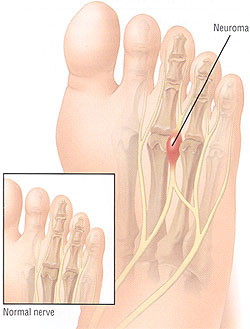What is Morton’s Neuroma?
A neuroma is a thickening of nerve tissue and Morton’s neuroma is a swollen, inflamed common digital nerve located between the bones at the ball of the foot. The most common location is in second (between second and third metatarsal) and third (between third and fourth metatarsals) spaces. This can cause a sharp, burning pain in the ball of your foot and sometimes the pain radiates to the toes.
What causes Morton’s Neuroma?
- Anything that causes compression or irritation of the nerve can cause a neuroma.
- Ill-fitting footwear such as shoes with narrow toebox, high heeled shoes or shoes with pointed toes.
- Being active and playing high impact sports that involve running and placing high pressure on the forefoot such as racquet sports
- Foot deformities – Pes planus (flat foot), bunion and hammertoes, the tight calf muscle (equinus deformity)

Conservative Treatments
Padding: Padding techniques to support for the metatarsal arch, thereby reducing the pressure on the nerve and decreasing the compression when walking.
Icing: Placing an icepack on the affected area helps reduce swelling.
Orthotic devices: Custom orthotic devices provide the support needed to reduce pressure and compression on the nerve.
Activity modifications: Activities that put repetitive pressure on the neuroma should be avoided until the condition improves.
Shoe modifications: Wear shoes with a wide toe box and avoid narrow-toed shoes or shoes with high heels.
Medications: Oral nonsteroidal anti-inflammatory drugs (NSAIDs), such as ibuprofen, may be recommended to reduce pain and inflammation.
Injection Therapy: This may include injections of cortisone with local anaesthetics or other agents such as sclerosing alcohol injection.
Surgical Treatment
Do I need surgery?
Surgery is considered in patients if conservative treatments have not responded well
What does the surgery involve?
- The surgery involves a small longitudinal incision(2-4 cm) on the top of the foot over the painful neuroma. Careful dissection, removal of the neuroma and skin closure are carried out in a gentle manner.
- Anaesthetics: Various anaesthetics are available (General or spinal block or local anaesthetics with sedation)
- The operation usually takes 30-60 minutes
After the surgery
- Keep your foot elevated as much as possible and apply an ice pack for the first week following surgery
- Your dressing will be changed between 3-7 days at the office after surgery
- Keep your dressing dry for the first 2 weeks after surgery
- Sutures will be removed between 2-3 weeks after surgery
- You are able to weight-bear on the heel or outside your foot in the postop surgical shoes
- You need expect to wear postop surgical shoes for 3-4 weeks


